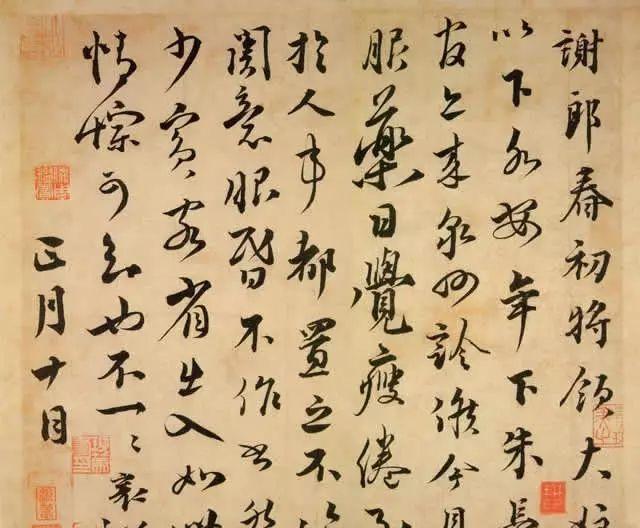Cai Xiang's "Xie Lang Ti", which is now stored in the National Palace Museum in Taipei, is also called "Early Spring Thesis", which is a subtle work that embodies Cai's style of writing. This is on paper, 26.5 cm in length and 29.1 cm in width. Appreciating this post, we can not only appreciate Cai Xiang's exquisite calligraphy, but also glimpse the relics of the Jin and Tang Dynasties and the author's admiration of Xuan Light's literary feelings.
"Shelang Thesis" should belong to his prime-age work. Qizha did not fall in the year, but there was a sentence in the letter that "also came to Quanzhou for medical treatment", so it should be written by Cai Xiang during his tenure in Quanzhou. This is gentle and elegant, thick and dignified. From the post, we know that the owner was physically violated at that time, and there was a disease in his body, "Chief Zhu also came to Quanzhou for diagnosis and waiting, and now he took medicine, and he felt thin and tired every day." Even so, the author is still rigorous in writing letters, and the way he writes is still calm. The lines in the opening line are not exciting, the lines are calm, and the press is measured. With the change of mood, the author's brush strokes gradually entered the line from kai, the lines were also rich and smooth, the line pen began to speed up, the pen was strong, and a trace of anxiety flowed out of the warmth. For example, the second line of "each" and "An" are written quickly, exaggerated in structure, and have a strong sense of movement, which fully shows the author's desire for peace and health. Another example is the fourth line of "medicine" and "thin" words, the strong contrast in structure accurately shows the author's state of mind, the word "medicine" is thick and composed with a pen, and the knot is broad and dynamic, all of which show the author's disappointment that the author hopes that the medicine will be removed from the disease but still "thin and tired" after taking it. The inadvertent shaking change of the two lines of "thin" ("thin" word skimming) naturally reveals the author's helplessness and anxiety. The more the author's mood changes, the more intense the mood changes, the heart moves with the emotion, the pen turns at will, or the line or the grass, the hand is picked up, there is no deliberate habit.

Cai Xiang Zhi Mu "Xie Lang Ti", 1060, on paper
26.5 cm in length and 29.1 cm in width, in the collection of the National Palace Museum in Taipei
【Interpretation】 Xie Lang chunchu generals the great bride and the following. In the following year, Governor Zhu also came to Quanzhou for consultation, and now he took medicine, and he felt tired and tired, and as for personnel, he did not care about it anymore. Dizzy do not make a book, but few guests, save in and out, so the feeling can be known. Not one by one. Send it off. The tenth day of the first month.
"Xie Lang Ti" because it is a family letter, so the author wrote without scruples, the heart moves at will, the layout is natural, deeply admired by the Jin people to advocate the essence of simplicity, to carve ornaments, less flashy, font size is staggered, but also the line is also Kai, wonderful creation of nature. For example, the words "xia", "zhu", "medicine", "jue" and so on in the text not only have the rigor and thickness of the script, but also do not lose the agility of the book; the words "things", "books", and "ke" are light in gesture and quiet in motion. The "Xie Lang Ti" has reached a considerable height in terms of style, weather and technique, and this intentional or unintentional calligraphy chest has undoubtedly laid a good theoretical and practical foundation for the opening of the "Shangyi" Song Dynasty calligraphy style.
"Xie Lang Ti" is comfortable and simple throughout, full of rich Jinren atmosphere, rigorous and thick with pen, with a degree of pressing, meticulous. The knot is born of each other, Gu Pan is interesting, the loose person is dignified and generous, the tight knot is beautiful and beautiful, and everywhere adheres to the strict law of Yan, Liu and Chu. Frankly speaking, it can skillfully blend the relaxed breath of the Jin people with the solemnity of the Tang dynasty and eventually form its own artistic style, looking at the Song Dynasty, only Cai Xiang has an ear
Cai Xiang (蔡襄), courtesy name Junmo , was a Fujian Xianyouren ( 殷游人 ) , born in the fifth year of Emperor Zhenzong 's reign , that is , in 1012 , and died in the fourth year of Emperor Yingzong 's reign , in 1067 , at the age of 55. Unlike Su, Huang, and Mi, he had a smooth career, a clean and honest official reputation, was busy with political affairs all his life, and achieved remarkable political achievements, while he himself was loyal, upright, and faithful, so he was respected by his colleagues in the DPRK and China and trusted by Emperor Renzong. This kind of loyalty and integrity in personality, smooth career and relatively relaxed political environment undoubtedly had an impact on the formation of Cai Xiang's style of writing, and it is also an objective reason why he is different from the other three styles of writing.